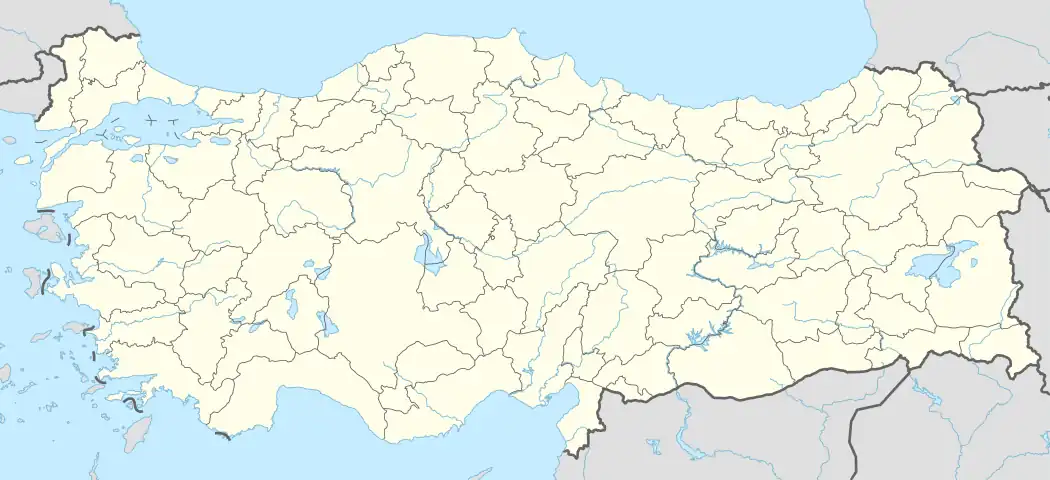Yarbaşı | |
|---|---|
 Yarbaşı Location in Turkey | |
| Coordinates: 37°23′28″N 41°51′58″E / 37.391°N 41.866°E | |
| Country | Turkey |
| Province | Şırnak |
| District | İdil |
| Population (2021)[1] | 1,182 |
| Time zone | TRT (UTC+3) |
Yarbaşı (Arabic: إِسفِس, Kurdish: Hespîst, Syriac: ܐܣܦܣ, romanized: Isfes)[2][nb 1] is a village in the İdil District of Şırnak Province in Turkey.[4] The village is populated by Kurds of the Omerkan tribe and had a population of 1,182 in 2021.[1][5]
History
Isfes (today called Yarbaşı) is identified with Hiaspis mentioned by the Roman historian Ammianus Marcellinus in the 4th century AD along the frontier with the Sasanian Empire.[7] It was noted as the location of the defection of the protector domesticus Antoninus to the Sasanian Empire.[8]
The Syriac Orthodox maphrian Basil Solomon took refuge at Isfes after having fled Mosul in 1514 and remained there until his death in 1518.[9]
An attack by Muhammad Pasha of Rawanduz on Isfes resulted in the death of 80 men, including a priest and a notable, and the enslavement of a number of women and children in early 1834.[10]
Amidst the Sayfo in 1915, the Assyrians of Isfes took refuge at Azakh where they were able to resist attacks from the Ottoman army and Kurds.[11]
The Assyrian population of Isfes began to emigrate to Al-Malikiyah in Syria from 1960 onwards and eventually the last Assyrian family left in 1980.[12]
References
Notes
Citations
- 1 2 "31 ARALIK 2021 TARİHLİ ADRESE DAYALI NÜFUS KAYIT SİSTEMİ (ADNKS) SONUÇLARI" (XLS). TÜİK (in Turkish). Retrieved 16 December 2022.
- ↑ Carlson, Thomas A. (14 January 2014). "Isfis". The Syriac Gazetteer. Retrieved 20 May 2023.
- ↑ Palmer 1990, p. 264; Courtois 2013, p. 147.
- ↑ "Türkiye Mülki İdare Bölümleri Envanteri". T.C. İçişleri Bakanlığı (in Turkish). Retrieved 19 December 2022.
- ↑ Baz (2016), p. 133.
- ↑ Palmer (1990), pp. 31–32.
- ↑ Palmer (1990), p. 4.
- ↑ Dignas & Winter (2007), p. 252.
- ↑ Barsoum (2009), pp. 163–164.
- ↑ Barsoum (2008), pp. 128–129.
- ↑ Sato (2001), p. 54.
- ↑ Courtois (2013), p. 147.
Bibliography
- Barsoum, Aphrem (2008). The History of Tur Abdin. Translated by Matti Moosa. Gorgias Press. Retrieved 1 April 2021.
- Barsoum, Aphrem (2009). The Collected Historical Essays of Aphram I Barsoum. Vol. 1. Translated by Matti Moosa. Gorgias Press. Retrieved 26 June 2021.
- Baz, Ibrahim (2016). Şırnak aşiretleri ve kültürü (in Turkish). p. 133. ISBN 9786058849631.
- Courtois, Sébastien de (2013). "Tur Abdin : Réflexions sur l'état présent descommunautés syriaques du Sud-Est de la Turquie,mémoire, exils, retours". Cahier du Gremmamo (in French). 21: 113–150.
- Dignas, Beate; Winter, Engelbert (2007). Rome and Persia in Late Antiquity: Neighbours and Rivals. Cambridge University Press.
- Palmer, Andrew (1990). Monk and Mason on the Tigris Frontier: The Early History of Tur Abdin. Cambridge University Press. Retrieved 15 July 2020.
- Sato, Noriko (2001). Memory and Social Identity among Syrian Orthodox Christians (PDF). Retrieved 27 December 2019.